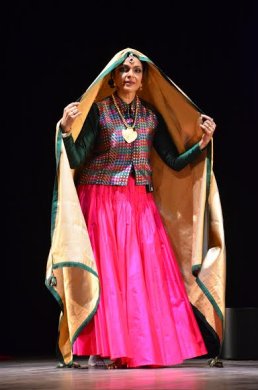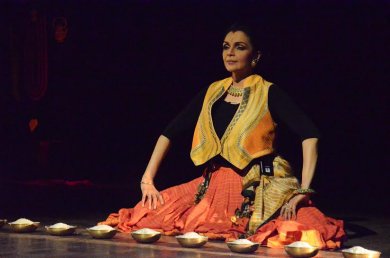
|   |

|   |
A Million Sitas: an epitome of imagination - Nita Vidyarthi e-mail: nitavidyarthi@gmail.com Photos courtesy: Inner Eye Communications April 14, 2015 On the closing evening of Pratibimb, a three-day festival of women in theatre presented by young actress Shahana Chatterjee and Inner Eye Communications at the G. D. Birla Sabhagar, Kolkata, celebrated dancer Anita Ratnam’s dramatic entry on stage for portrayal of a different take on the age-old meek Sita, had the spectators awed. The curtain rose perfectly on an indefinable relationship of magnificence and semi-gloom in the setting.  The riveting performance begins with the spotlight on Ratnam in front of masks planted on two placards, one with a blue King’s face with a lotus and a bow hanging from the sides of a vertical plank depicting Rama, and another similar one of Ravana with a sword and a kamandalu (round water-pot with a spout) on the left at the backdrop of the stage as the simple sets. Sita (Ratnam) narrates the story of her birth. The thought-provoking exploration of relationships with Sita seamlessly encompasses dance-theatre, mime, storytelling, conversation and movement and emerges as an exceptional study of mythology’s most misunderstood protagonist. Sita becomes the central figure and link connecting with other pivotal female characters from Ramayana - Ahalya, Manthara, Surpanakha and Mandodari - all women with strong identities. Instead of following the popular Valmiki, Tulsidas or Kamban versions of the story, Anita has researched and drawn from lesser-known retellings of the Ramayana in Kannada, Tamil, Telugu, Himachali, Odia and Bengali, much of it from women’s oral traditions. She even adapts from the Thai and Indonesian versions. These account for the unusual portrayals and situations depicted. So, Manthara transforms into a butterfly and Surpanakha, a field Marshal in Ravana’s army. The language is also unconventional - English with a sprinkling of Sanskrit, Telugu, Kannada and Tamil and theatre. The dance theatre begins from the birth of Sita as the metallic sound of gongs together with edakka, ushers in Ratnam to introduce herself as, “This is Sita, daughter of Ravana, adopted daughter of Janaka.” King Janaka discovers her at the tip of the plough. So, she is Sita and Janaki. As the story unfolds, the audience is awestruck with the visual character of the ambivalence between dramaturgy and theatre. Sita’s birth from Ravana’s nostrils after he overate mangoes (given by Shiva) and sneezed, throws an edgy yet comical curve into the versatility of movements displayed by the dancer. Kalari, Kathakali, Qi Jong, yoga, meditation, including movements in silence, and Tai Chi all go into the choreography by Ratnam and Hari Krishnan performed in the Neo-Bharatam style, based on a Bharatanatyam foundation. The aesthetics of the presentation apart from great dancing was an asset. The lights by Victor Paulraj and the simple sets provided a perfect foil to the character, so did the informal costumes of Rajasthani folk skirts, flavoured with waist-coats by Tarun Tahiliani. The lotus pond where Janaki relaxes was virtually real with synthetic lotuses. The multiple uses of these flexible lotus stems showed imagination. A novelty was the 9 bowls of rice arranged in a row with a mango on top and the dancing took place at times in front of it. According to Ratnam, the 9 bowls depict the 9 heads of Ravana and the tenth one is hers! Fascinating, stunning and an epitome of imagination! The live music with singer Sharanya Krishnan, L. Subhashri, and Paramita at the front corner of the stage helped the dramaturgy and dance to gain a greater range of dynamics, emotion and richer expressiveness as in the lilting “Sitamma Mayamma” and “Sita Kalyanam Vaibogamey” not forgetting to mention the poignant refrain “Aaraaro aareeraaro” which emphasizes the narration that “war is kind to men; it makes them heroes or villains, it’s the women who are left behind.” 

Between episodes came the “taketat dhin taka” bols to avoid overlap. The Surpanakha episode (her nose was mutilated but she did not get justice. Nobody had pride and lust like her for Rama) with all its grandeur of costumes, scintillating claws, a tiara-type of head dress, the sparkling yet anguish-filled face accentuated by her monologues were a riotous triumph in totality. Her most pronounced success was in her rendering with a deep araimandi, Kathakali and Kalari moves, stretched, taut hand movements influenced by Makyong, the traditional form of dance from Northern Malaysia. Equally convincing was the Manthara episode and the mystical yet powerful conclusion that Sita is not the weak, meek beloved of Rama but a strong woman with a discerning mind who asserts herself and protests. The tempestuous movements recalled the tempestuous moments of millions of women as the captivating execution, exuberance and performing evolutions of Anita Ratnam as Sita, ardently reminded, I am Sita, Janaki, Ahalya, Manthara, Mandodari, Surpanakha, Anita, Rajyalakshmi, Nafisa, Padma, Carol... in the concluding statement. An unforgettable performance with a pulsating union of movement, sound, lights and stunning costumes exploring the contemporary flavour in the traditional text and dance form. Dr. Nita Vidyarthi is a critic of performing arts, specialising in dance, dance theatre and expressions and is a regular contributor to The Hindu, and the Statesman Kolkata in dance, vocal music and theatre. She is trained in Kathak, Bharatanatyam and Manipuri as well as vocal, semi-classical music and Rabindra Sangeet. A Science communicator, Ph.D. in Polymer Science, Commonwealth Scholar and a retired Professor of Chemistry, Nita devotes most of her time to dance and theatre writing. |